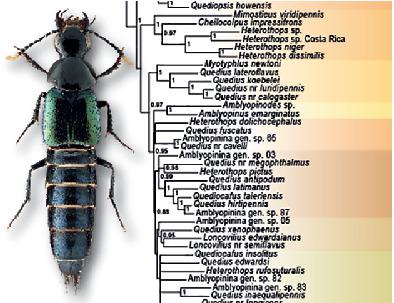当前位置:
X-MOL 学术
›
Syst. Entomol.
›
论文详情
Our official English website, www.x-mol.net, welcomes your feedback! (Note: you will need to create a separate account there.)
Molecular phylogeny illuminates Amblyopinini (Coleoptera: Staphylinidae) rove beetles as a target for systematic and evolutionary research
Systematic Entomology ( IF 4.8 ) Pub Date : 2019-12-03 , DOI: 10.1111/syen.12405 Josh Jenkins Shaw 1, 2 , Dagmara Żyła 3, 4 , Alexey Solodovnikov 2
Systematic Entomology ( IF 4.8 ) Pub Date : 2019-12-03 , DOI: 10.1111/syen.12405 Josh Jenkins Shaw 1, 2 , Dagmara Żyła 3, 4 , Alexey Solodovnikov 2
Affiliation

|
The rove beetle tribe Amblyopinini (Coleoptera: Staphylinidae: Staphylininae) is a recently discovered monophyletic lineage comprising an estimated 1000 or more species of mainly leaf‐ and log litter‐dwelling predatory insects found throughout the southern hemisphere. Of these, a single genus Heterothops Stephens somehow conquered all continents in the northern hemisphere as well. A few lineages of amblyopinines independently evolved into highly derived predators of mammal ectoparasites from free‐living ancestors. In return, they are tolerated in the mammal fur and nests, which is a unique example of cleaning symbiosis between insects and vertebrates. For over a century the great majority of free‐living southern amblyopinines were incorrectly placed in the northern hemisphere‐restricted, and superficially similar, rove beetle genera from the subtribe Quediina. Only their mammal‐associated derived forms were understood as amblyopinines, a nonmonophyletic taxon of volatile status and enigmatic sister‐group relationships of its various members. Here we present the first comprehensive phylogeny of Amblyopinini inferred with Bayesian analysis of a six‐gene molecular dataset (4672 bp) across a broad sample of taxa (90 species). This phylogeny provides a framework for the badly needed taxonomic inventory of this group and, in particular, reveals at least two independent origins of mammal association within the tribe. It frames the upcoming in‐depth interdisciplinary exploration of a variety of phenomena such as evolution of the austral biota in response to continental drift and climate change, biotic exchange between southern and northern continents, origin and evolution of beetle–mammal symbiosis, and pathways and constraints of the evolutionary parallelisms.
中文翻译:

分子系统发育阐明Amblyopinini(鞘翅目:Staphylinidae)罗夫甲虫作为系统和进化研究的目标
罗夫甲虫部落 Amblyopinini(鞘翅目:Staphylinidae:Staphylininae)是最近发现的单系谱系,包括估计 1000 或更多物种,主要栖息在树叶和原木枯枝落叶中的捕食性昆虫遍布整个南半球。其中,一个单一的 Heterothops Stephens 属也以某种方式征服了北半球的所有大陆。少数弱蛋白亚种谱系从自由生活的祖先独立进化为高度衍生的哺乳动物体外寄生虫捕食者。作为回报,它们在哺乳动物的毛皮和巢穴中被容忍,这是昆虫和脊椎动物之间清洁共生的独特例子。一个多世纪以来,绝大多数自由生活的南方弱碱被错误地置于北半球限制,表面上相似,来自亚部落 Quediina 的 rove 甲虫属。只有它们与哺乳动物相关的衍生形式被理解为 amblyopinines,一种不稳定状态的非单系分类群,其各种成员的神秘姐妹群关系。在这里,我们展示了 Amblyopinini 的第一个综合系统发育,通过贝叶斯分析对广泛的分类群(90 种)样本的六基因分子数据集(4672 bp)进行了推断。这种系统发育为该群体急需的分类清单提供了一个框架,特别是揭示了部落内哺乳动物关联的至少两个独立起源。它构建了即将对各种现象进行的深入跨学科探索,例如响应大陆漂移和气候变化的南方生物群进化、南北大陆之间的生物交换、
更新日期:2019-12-03
中文翻译:

分子系统发育阐明Amblyopinini(鞘翅目:Staphylinidae)罗夫甲虫作为系统和进化研究的目标
罗夫甲虫部落 Amblyopinini(鞘翅目:Staphylinidae:Staphylininae)是最近发现的单系谱系,包括估计 1000 或更多物种,主要栖息在树叶和原木枯枝落叶中的捕食性昆虫遍布整个南半球。其中,一个单一的 Heterothops Stephens 属也以某种方式征服了北半球的所有大陆。少数弱蛋白亚种谱系从自由生活的祖先独立进化为高度衍生的哺乳动物体外寄生虫捕食者。作为回报,它们在哺乳动物的毛皮和巢穴中被容忍,这是昆虫和脊椎动物之间清洁共生的独特例子。一个多世纪以来,绝大多数自由生活的南方弱碱被错误地置于北半球限制,表面上相似,来自亚部落 Quediina 的 rove 甲虫属。只有它们与哺乳动物相关的衍生形式被理解为 amblyopinines,一种不稳定状态的非单系分类群,其各种成员的神秘姐妹群关系。在这里,我们展示了 Amblyopinini 的第一个综合系统发育,通过贝叶斯分析对广泛的分类群(90 种)样本的六基因分子数据集(4672 bp)进行了推断。这种系统发育为该群体急需的分类清单提供了一个框架,特别是揭示了部落内哺乳动物关联的至少两个独立起源。它构建了即将对各种现象进行的深入跨学科探索,例如响应大陆漂移和气候变化的南方生物群进化、南北大陆之间的生物交换、



























 京公网安备 11010802027423号
京公网安备 11010802027423号